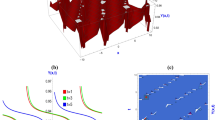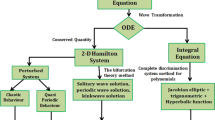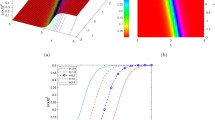Abstract
The nonlinear dynamical behavior of a micromechanical resonator acting as one of the mirrors in an optical resonance cavity is investigated. The mechanical motion is coupled to the optical power circulating inside the cavity both directly through the radiation pressure and indirectly through heating that gives rise to a frequency shift in the mechanical resonance and to thermal deformation. The energy stored in the optical cavity is assumed to follow the mirror displacement without any lag. In contrast, a finite thermal relaxation rate introduces retardation effects into the mechanical equation of motion through temperature dependent terms. Using a combined harmonic balance and averaging technique, slow envelope evolution equations are derived. In the limit of small mechanical vibrations, the micromechanical system can be described as a nonlinear Duffing-like oscillator. Coupling to the optical cavity is shown to introduce corrections to the linear dissipation, the nonlinear dissipation and the nonlinear elastic constants of the micromechanical mirror. The magnitude and the sign of these corrections depend on the exact position of the mirror and on the optical power incident on the cavity. In particular, the effective linear dissipation can become negative, causing self-excited mechanical oscillations to occur as a result of either a subcritical or supercritical Hopf bifurcation. The full slow envelope evolution equations are used to derive the amplitudes and the corresponding oscillation frequencies of different limit cycles, and the bifurcation behavior is analyzed in detail. Finally, the theoretical results are compared to numerical simulations using realistic values of various physical parameters, showing a very good correspondence.











Similar content being viewed by others
References
Crookes, W.: On attraction and repulsion resulting from radiation—Part II. Proc. R. Soc. Lond. 23, 373–378 (1874–1875)
Lebedew, P.: Untersuchungen über die druckkräfte des lichtes. Ann. Phys. 311, 433–458 (1901). Russian translation in P. Lebedew, ‘Selected Works’, A.K. Timiriazev (ed.), Moscow, 1949
Nichols, E.F., Hull, G.F.: A preliminary communication on the pressure of heat and light radiation. Phys. Rev. I 13(5), 307–320 (1901)
Hollerman, W.A.: The Physics of Solar Sails. NASA Marshall Space Flight Center, MSFC, Huntsville (2002)
Braginsky, V.B., Manukin, A.B.: Ponderomotive effects of electromagnetic radiation. Zh. Eksp.Teor. Fiz. 52, 986–989 (1967) (in Russian)
Braginsky, V.B., Manukin, A.B., Tikhonov, M.Yu.: Investigation of dissipative ponderomotive effects of electromagnetic radiation. Zh. Eksp.Teor. Fiz. 58, 1550–1555 (1970) (in Russian)
Kimble, H.J., Levin, Y., Matsko, A.B., Thorne, K.S., Vyatchanin, S.P.: Conversion of conventional gravitational-wave interferometers into quantum nondemolition interferometers by modifying their input and/or output optics. Phys. Rev. D 65, 022002 (2001)
Corbitt, T., Ottaway, D., Innerhofer, E., Pelc, J., Mavalvala, N.: Measurement of radiation-pressure-induced optomechanical dynamics in a suspended Fabry-Perot cavity. Phys. Rev. A 74, 021802 (2006)
Kippenberg, T.J., Vahala, K.J.: Cavity optomechanics: Back-action at the mesoscale. Science 321(5893), 1172–1176 (2008)
Schliesser, A., Riviere, R., Anetsberger, G., Arcizet, O., Kippenberg, T.J.: Resolved-sideband cooling of a micromechanical oscillator. Nat. Phys. 4, 415–419 (2008)
Genes, C., Vitali, D., Tombesi, P., Gigan, S., Aspelmeyer, M.: Ground-state cooling of a micromechanical oscillator: Comparing cold damping and cavity-assisted cooling schemes. Phys. Rev. A 77, 033804 (2008)
Teufel, J.D., Li, D., Allman, M.S., Cicak, K., Sirois, A.J., Whittaker, J.D., Simmonds, R.W.: Circuit cavity electromechanics in the strong coupling regime. arXiv:1011.3067 (2010)
Carmon, T., Rokhsari, H., Yang, L., Kippenberg, T.J., Vahala, K.J.: Temporal behavior of radiation-pressure-induced vibrations of an optical microcavity phonon mode. Phys. Rev. Lett. 94, 223902 (2005)
Arcizet, O., Cohadon, P.-F., Briant, T., Pinard, M., Heidmann, A.: Radiation-pressure cooling and optomechanical instability of a micromirror. Nature 444, 71–74 (2006)
Gigan, S., Böhm, H.R., Paternostro, M., Blaser, F., Langer, G., Hertzberg, J.B., Schwab, K.C., Bäuerle, D., Aspelmeyer, M., Zeilinger, A.: Self-cooling of a micromirror by radiation pressure. Nature 444, 67–70 (2006)
Paternostro, M., Gigan, S., Kim, M.S., Blaser, F., Böhm, H.R., Aspelmeyer, M.: Reconstructing the dynamics of a movable mirror in a detuned optical cavity. New J. Phys. 8, 107 (2006)
Jayich, A.M., Sankey, J.C., Zwickl, B.M., Yang, C., Thompson, J.D., Girvin, S.M., Clerk, A.A., Marquardt, F., Harris, J.G.E.: Dispersive optomechanics: A membrane inside a cavity. New J. Phys. 10, 095008 (2008)
Marino, F., Marin, F.: Chaotically spiking attractors in suspended mirror optical cavities. arXiv:1006.3509 (2010)
Stokes, N.A.D., Fatah, R.M.A., Venkatesh, S.: Self-excitation in fibre-optic microresonator sensors. Sens. Actuators A 21, 369–372 (1990)
Hane, K., Suzuki, K.: Self-excited vibration of a self-supporting thin film caused by laser irradiation. Sens. Actuators A 51, 179–182 (1996)
Metzger, C., Karrai, K.: Cavity cooling of a microlever. Nature 432, 1002–1005 (2004)
Jourdan, G., Comin, F., Chevrier, J.: Mechanical mode dependence of bolometric backaction in an atomic force microscopy microlever. Phys. Rev. Lett. 101, 133904 (2008)
Metzger, C., Ludwig, M., Neuenhahn, C., Ortlieb, A., Favero, I., Karrai, K., Marquardt, F.: Self-induced oscillations in an optomechanical system driven by bolometric backaction. Phys. Rev. Lett. 101, 133903 (2008)
Ludwig, M., Neuenhahn, C., Metzger, C., Ortlieb, A., Favero, I., Karrai, K., Marquardt, F.: Self-induced oscillations in an optomechanical system. arXiv:0711.2661 (2007)
Restrepo, J., Gabelli, J., Ciuti, C., Favero, I.: Classical and quantum theory of photothermal cavity cooling of a mechanical oscillator. arXiv:1011.3911 (2010)
Liberato, S.D., Lambert, N., Nori, F.: Quantum limit of photothermal cooling. arXiv:1011.6295 (2010)
Velikovich, A.L., Golubev, G.P., Golubchenko, V.P., Luchinsky, D.G.: Tristability and self-oscillations in a double resonator system. Opt. Commun. 80, 444–452 (1991)
Braginsky, V.B., Strigin, S.E., Vyatchanin, S.P.: Parametric oscillatory instability in Fabry-Perot (FP) interferometer. Phys. Lett. A 287, 331–337 (2001)
Kim, K., Lee, S.: Self-oscillation mode induced in an atomic force microscope cantilever. J. Appl. Phys. 91(7), 4715 (2002)
Aubin, K., Zalalutdinov, M., Alan, T., Reichenbach, R.B., Rand, R., Zehnder, A., Parpia, J., Craighead, H.: Limit cycle oscillations in CW laser-driven NEMS. J. Microelectromech. Syst. 13, 1018–1026 (2004)
Kippenberg, T.J., Rokhsari, H., Carmon, T., Scherer, A., Vahala, K.J.: Analysis of radiation-pressure induced mechanical oscillation of an optical microcavity. Phys. Rev. Lett. 95, 033901 (2005)
Marquardt, F., Harris, J.G.E., Girvin, S.M.: Dynamical multistability induced by radiation pressure in high-finesse micromechanical optical cavities. Phys. Rev. Lett. 96, 103901 (2006)
Sahai, T., Bhiladvala, R.B., Zehnder, A.T.: Thermomechanical transitions in doubly-clamped micro-oscillators. Int. J. Non-Linear Mech. 42, 596–607 (2007)
Lyshevski, S.E., Lyshevski, M.A.: Nano- and microoptoelectromechanical systems and nanoscale active optics. In: Third IEEE Conference on Nanotechnology, 2003, vol. 2, pp. 840–843 (2003)
Wu, M.C., Solgaard, O., Ford, J.E.: Optical MEMS for lightwave communication. J. Lightwave Technol. 24(12), 4433–4454 (2006)
Hossein-Zadeh, M., Vahala, K.J.: An optomechanical oscillator on a silicon chip. IEEE J. Sel. Top. Quantum Electron. 16(1), 276–287 (2010)
Dykman, M.I., Krivoglaz, M.A.: Theory of nonlinear oscillator interacting with a medium. In: Khalatnikov, I.M. (ed.) Soviet Scientific Reviews, Section A. Physics Reviews, vol. 5, pp. 265–441. Harwood Academic, Reading (1984)
Nayfeh, A.H., Mook, D.T.: Nonlinear Oscillations. Wiley Classics Library. Wiley, New York (1995)
Szemplińska-Stupnicka, W.: The Behavior of Nonlinear Vibrating Systems. Mechanics: Dynamical Systems. Kluwer Academic Publishers, Dordrecht (1990)
Strogatz, S.H.: Nonlinear Dynamics and Chaos: With Applications to Physics, Biology, Chemistry, and Engineering. Perseus Books, New York (1994)
Ludwig, M., Kubala, B., Marquardt, F.: The optomechanical instability in the quantum regime. New J. Phys. 10, 095013 (2008)
Lazarus, A., Barois, T., Perisanu, S., Poncharal, P., Manneville, P., de Langre, E., Purcell, S.T., Vincent, P., Ayari, A.: Simple modeling of self-oscillation in nano-electro-mechanical systems. arXiv:1004.1062 (2010)
Zaitsev, S., Pandey, A.K., Shtempluck, O., Buks, E.: Forced and self-excited oscillations of an optomechanical cavity. Phys. Rev. E 84, 046605 (2011)
Yariv, A.: Optical Electronics, 4th edn. The Holt, Rinehart and Winston Series in Electrical Engineering. Saunders College Publishing, Philadelphia (1991)
Jackson, J.D.: Classical Electrodynamics. Wiley, New York (1999)
McVoy, K.W., Heller, L., Bolsterli, M.: Optical analysis of potential well resonances. Rev. Mod. Phys. 39(1), 245–258 (1967)
Sumetsky, M., Eggleton, B.: Modeling and optimization of complex photonic resonant cavity circuits. Opt. Express 11(4), 381–391 (2003)
Viviescas, C., Hackenbroich, G.: Field quantization for open optical cavities. Phys. Rev. A 67, 013805 (2003)
Zaitsev, S., Shtempluck, O., Buks, E., Gottlieb, O.: Nonlinear damping in a micromechanical oscillator. Nonlinear Dyn. 67, 859–883 (2012)
Xu, J., Chung, K.W.: Effects of time delayed position feedback on a van der Pol-{D}uffing oscillator. Physica D 180, 17–39 (2003)
Lifshitz, R., Cross, M.C.: Nonlinear dynamics of nanomechanical and micromechanical resonators. In: Schuster, H.G. (ed.) Reviews of Nonlinear Dynamics and Complexity, vol. 1, pp. 1–48. Wiley-VCH, Weinheim (2008)
Guckel, H., Burns, D., Rutigliano, C., Lovell, E., Choi, B.: Diagnostic microstructures for the measurement of intrinsic strain in thin films. J. Micromech. Microeng. 2(2), 86–95 (1992)
Fang, W., Wickert, J.A.: Post buckling of micromachined beams. J. Micromech. Microeng. 4, 116–122 (1994)
Guckenheimer, J., Holmes, P.: Nonlinear Oscillations, Dynamical Systems, and Bifurcations of Vector Fields. Applied Mathematical Sciences, vol. 42. Springer, Berlin (1983)
Pandey, A.K., Gottlieb, O., Shtempluck, O., Buks, E.: Performance of an AuPd micromechanical resonator as a temperature sensor. Appl. Phys. Lett. 96, 203105 (2010)
Nayfeh, A.H.: Introduction to Perturbation Techniques. Wiley, New York (1981)
Acknowledgements
This work is supported by the German Israel Foundation under Grant 1-2038.1114.07, the Israel Science Foundation under Grant 1380021, the Deborah Foundation, Eliyahu Pen Research Fund, Russell Berrie Nanotechnology Institute, the European STREP QNEMS Project, and MAFAT.
Author information
Authors and Affiliations
Corresponding author
Appendices
Appendix A: Spatial Fourier series of a periodic optical power function
In order to calculate an analytical expression for c k in Sect. 2.1, we proceed as follows. We rewrite (1) and (4) as
where



Multiplying both sides of (47a) by 1+h-cosy, using the fact that cosy=(e jy+e -jy)/2, and separating terms corresponding to different harmonics, one finds
Note that β k =β -k , and β k are real because I(y) is a real even function. Assuming that β k can be represented as
where χ and α are real, and substituting (49) into (48) for positive values of k results in
The solution which ensures series convergence by satisfying the condition 0<α<1 is
The value of χ can be found from (48) for the case in which k=0, giving
Finally, (47d) gives
It is straightforward to show that if the finesse is bigger than unity, i.e.,  is of order of ten or higher, the truncation error in (6) is negligible if
is of order of ten or higher, the truncation error in (6) is negligible if  .
.
An example of several truncated Fourier series calculated using (50a)–(50c) for different values of \(k_{\text{max}}\) is shown in Fig. 12.
(Color online) Comparison between an exact periodic function describing the optical power in a resonator given in (1) (solid black line) and its truncated spatial Fourier series. The optical resonance width is Γ=0.05L. Red dotted line corresponds to \(k_{\text{max}}=3\). Blue dashed line corresponds to \(k_{\text{max}}=15\)
Appendix B: Equilibrium analysis of the equations of motion
In this section, we analyze the equilibrium position of the third-order autonomous nonlinear dynamical system defined by (7) and (9) where the external exciting force is zero (f m =0).
By defining new variables \(p=\dot{x}\) and ΔT=T-T 0, the equations of motion can be rewritten as



where parameters defined in Sect. 2.2 have been used.
The equilibrium position of the dynamical system (i.e., the fixed point) is readily obtained by setting the velocities (i.e., the left-hand side of (51a)–(51c)) to zero. This results in a transcendental function for the equilibrium displacement A 0s ,
where the equilibrium temperature shift ΔT 0 is
and the equilibrium mechanical resonance frequency is
In the limit of a very small equilibrium displacement A 0s ≈0 (i.e., the limit of very weak optomechanical forces), (52a)–(52c) converge to the similar equations (26a)–(26c) derived in Sect. 2.5.
In general, multiple solutions of (52a)–(52c) may coexist, corresponding to several stable and unstable fixed points under the same experimental conditions. However, in the case in which the thermal frequency shift, the radiation pressure and the thermal force are all considered small, the limiting case of (26a)–(26c) predicts a single stable fixed point with a small static displacement A 0s ≪Γ.
Stability of the equilibrium is obtained via a local perturbation of the system fixed point defined by (52a)–(52c), resulting in a linear variation
where M is the Jacobian matrix of the first derivatives of the system functions given by the right hand parts of (51a)–(51c). Thus, equilibrium stability can readily be obtained by evaluating the eigenvalues λ 1, λ 2, and λ 3 of M, which satisfy
where



and where a prime denotes differentiation with respect to the mechanical displacement x.
Asymptotic stability of the equilibrium (i.e., \(\operatorname {Re}\{\lambda_{i}\}<0\)) is defined by positive coefficients and a positive second Hurwitz determinant, namely, c i >0 and Δ 2=(c 1 c 2-c 3)>0. Loss of equilibrium stability is defined by a zero eigenvalue (c 3=0), or a Hopf bifurcation where the Jacobian matrix M has a pair of pure imaginary eigenvalues, i.e., λ 1,2=±iω H .
The zero eigenvalue condition c 3=0 can be rewritten in a differential form as

This equation can be readily understood as a condition of equality between the thermally dependent nonlinear elastic force (left-hand side terms) and the optomechanical forces (right-hand side terms). This condition describes a saddle-node bifurcation, which can be reached for the case of larger optomechanical coupling than considered in this work. Note that the validity of the assumptions made in Sect. 2.2, especially the linear temperature dependence of the mechanical frequency and the thermal force, has to be carefully assessed in this case.
The Hopf bifurcation, which implies that periodic limit cycle oscillations can occur near the bifurcation threshold [54], can readily be shown to correspond to a zero second Hurwitz determinant, i.e., c 1 c 2-c 3=0, with a positive Hopf frequency \(\omega_{H}=\sqrt{c_{2}}\). Using (53a)–(53c), we find the bifurcation threshold condition to be

If we assume the mechanical dissipation, the nonlinear effects and the optomechanical coupling to be weak, namely, we assume the thermal frequency shift, the static displacement, the nonlinear and dissipation terms, the radiation pressure and the thermal force to be small, and, therefore, neglect all the small terms of the second order and higher, then the right-hand side of (54) vanishes. In this limit, the Hopf bifurcation condition given in (54) coincides with the condition γ=0 discussed in Sect. 3.1 [see (32a) and (37)].
Under the same assumptions, the Hopf frequency becomes
where Δω s is defined in (26a) and (32b). This result coincides with the limit cycle frequency expression given in (43) in the limit of vanishing limit cycle amplitude.
We note that the Hopf bifurcation can either be supercritical or subcritical, culminating with stable or unstable self-excited limit-cycle solutions which are discussed in Sect. 4.
Appendix C: Averaging of the equations of motion
Using (6) and (20), we write the optical power expression I as
It is beneficial to use the Jacobi–Anger expansion
where z and ξ are some real variables, and J n (z) is the Bessel function of n-th order. The optical power expression given in (56) can be rewritten as
where P n are defined in (24).
Next, we proceed to write the integral in (13) explicitly. Slow envelope approximation implies that the amplitude A 1, and the phase \(\tilde{\phi}\) do not undergo significant changes at timescales comparable to \(\omega_{0}^{-1}\). It follows that A 1 and \(\tilde{\phi}\) can be regarded as constants at timescales of order \(\omega_{0}^{-1}\) and κ -1, and terms involving K in (16) can be estimated using the approximate equality
where g(τ-t) is either e κ(τ-t), \(e^{(\kappa\pm j\omega _{0})(\tau-t)}\) or \(e^{(\kappa\pm j2\omega_{0})(\tau-t)}\), f(t) is a function of slow varying terms A 1 and \(\tilde{\phi}\), and all fast decaying terms in ∫g(τ-t) dτ should be neglected. The result is

In order to solve (16) under the conditions described above, we use the harmonic balance method followed by the Krylov–Bogoliubov averaging technique [56], and require


It follows that
Introducing (61a), (61b) into (16) results in

Collecting all nonharmonic terms in (63) gives the expression for A 0:

where Ω is defined in (23), and terms proportional to (βηK)2 have been neglected because the frequency correction due to heating is considered small, i.e., βηK(I)≪ω 0. The term Δω 0 can be identified as a small frequency correction due to the heating of the mirror averaged over one mechanical oscillation period.
Equation (64) can be further simplified by assuming the static displacement A 0 to be small and using the weak nonlinearity assumption, i.e., \(\alpha_{3}A_{0}^{2}\ll\omega_{0}^{2}\), giving rise to (22).
The remaining terms in (63) constitute the following relationship [see also (58) and (60)]:
where

Here, \(\operatorname{NST}\) denotes the non secular terms (i.e., higher harmonics).
Equations (62) and (65) can be rearranged as follows:


Averaging of (67a), (67b) over one period of ψ can be made under the assumption of slow varying envelope, namely,


Substituting (66) into (68a), (68b) yields the slow envelope evolution equations (25a), (25b).
Rights and permissions
About this article
Cite this article
Zaitsev, S., Gottlieb, O. & Buks, E. Nonlinear dynamics of a microelectromechanical mirror in an optical resonance cavity. Nonlinear Dyn 69, 1589–1610 (2012). https://doi.org/10.1007/s11071-012-0371-9
Received:
Accepted:
Published:
Issue Date:
DOI: https://doi.org/10.1007/s11071-012-0371-9





